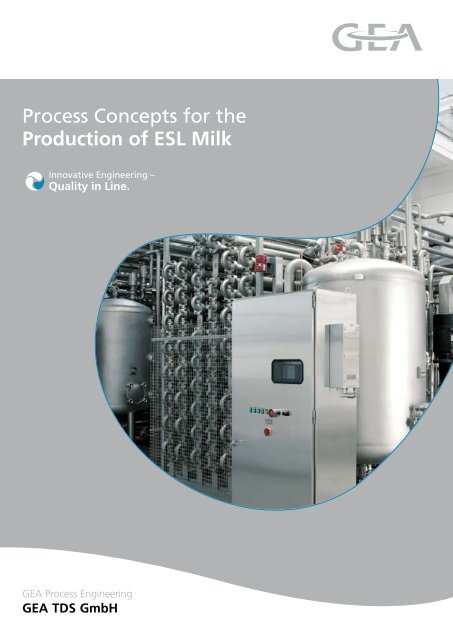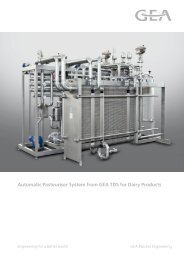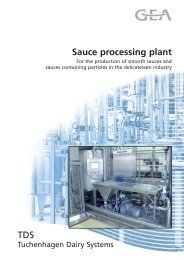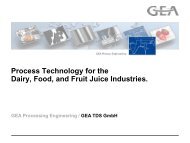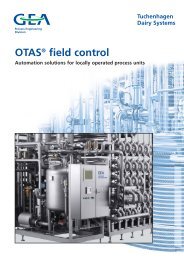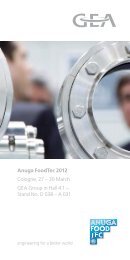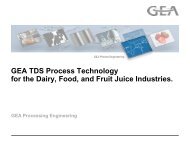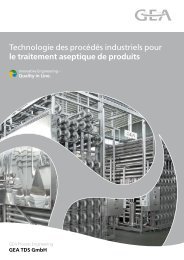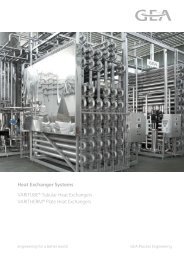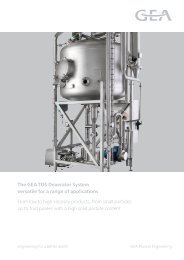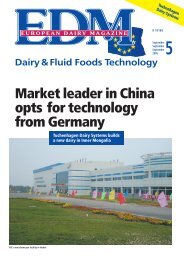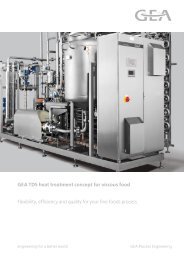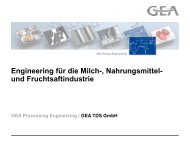Process Concepts for the Production of ESL Milk - Gea-tds.com
Process Concepts for the Production of ESL Milk - Gea-tds.com
Process Concepts for the Production of ESL Milk - Gea-tds.com
You also want an ePaper? Increase the reach of your titles
YUMPU automatically turns print PDFs into web optimized ePapers that Google loves.
<strong>Process</strong> <strong>Concepts</strong> <strong>for</strong> <strong>the</strong><br />
<strong>Production</strong> <strong>of</strong> <strong>ESL</strong> <strong>Milk</strong><br />
Innovative Engineering –<br />
Quality in Line.<br />
GEA <strong>Process</strong> Engineering<br />
GEA TDS GmbH
Fundamentals and Direct Heating M<br />
… are <strong>the</strong> basis <strong>for</strong> an<br />
extended fresh milk shelf life.<br />
Fresh milk with an extended shelf<br />
life is also referred to as <strong>ESL</strong> milk. An<br />
exact, generally accepted definition <strong>of</strong><br />
<strong>the</strong> term <strong>ESL</strong> milk with regard to shelf<br />
life does not yet exist.<br />
GEA TDS uses <strong>the</strong> following definition<br />
<strong>for</strong> <strong>ESL</strong> milk:<br />
<strong>ESL</strong> milk is milk with a shelf life <strong>of</strong><br />
at least 21 days when stored at ≤ 8° C.<br />
From a sensory quality point <strong>of</strong> view,<br />
virtually no loss can be detected in<br />
<strong>com</strong>parison with conventional fresh<br />
milk (shelf life <strong>of</strong> 6–12 days).<br />
<strong>ESL</strong> milk is more than a product<br />
with an extended shelf life. It is also<br />
synonymous with <strong>the</strong> high hygienic<br />
standard <strong>of</strong> <strong>the</strong> process technology<br />
required to produce it.
ethods …<br />
The chart illustrates <strong>the</strong> factors contributing<br />
to <strong>the</strong> extension <strong>of</strong> shelf life.<br />
The first column shows <strong>the</strong> general<br />
factors, such as requirements placed on<br />
raw milk quality, processing and packaging<br />
technology as well as an uninterrupted<br />
cold chain.<br />
Microbial reduction methods which,<br />
<strong>com</strong>pared to traditional pasteurisation,<br />
destroy an additional percentage <strong>of</strong> <strong>the</strong><br />
surviving microorganism are listed in<br />
<strong>the</strong> second column.<br />
General factors<br />
raw milk<br />
process technology<br />
packaging technology<br />
continuous cold chain<br />
Shelf life <strong>of</strong> <strong>ESL</strong> milk<br />
Microbial reduction methods<br />
direct heating<br />
indirect heating with tubes<br />
modificated pasteuriser<br />
micr<strong>of</strong>iltration<br />
deep-bed filtration<br />
bacteria-removing separation<br />
On <strong>the</strong> following pages we will discuss<br />
<strong>the</strong> general factors from <strong>the</strong> first column.<br />
We will <strong>the</strong>n outline <strong>the</strong> individual<br />
microbial reduction process<br />
concepts.<br />
2<br />
3
General Shelf Life Extending Facto<br />
<strong>Process</strong> standards<br />
category valve technology storage<br />
tank design<br />
standard<br />
standard valve<br />
technology<br />
Quality <strong>of</strong> raw milk, process<br />
and packaging technology<br />
as well as <strong>the</strong> cold chain are<br />
counted among <strong>the</strong> general<br />
factors which influence <strong>the</strong><br />
shelf life <strong>of</strong> <strong>ESL</strong> milk.<br />
filling<br />
technology<br />
expected shelf<br />
life at 8° C<br />
no air blanketing standard line 10 days<br />
Quality <strong>of</strong> raw milk:<br />
To produce <strong>ESL</strong> milk, a low original<br />
bacterial count in <strong>the</strong> raw milk is<br />
re<strong>com</strong>mended. A microbial count <strong>of</strong><br />
100,000 cfu should not be exceeded.<br />
<strong>Process</strong> technology:<br />
Depending on <strong>the</strong> plant design, fur<strong>the</strong>r<br />
microbial growth in <strong>the</strong> milk can be<br />
prevented. The chart process standards<br />
classifies <strong>the</strong> categories: standard,<br />
clean, ultra-clean and aseptic. Standard<br />
and clean ensure a fresh milk shelf life<br />
<strong>of</strong> 10–12 days. The production process<br />
<strong>for</strong> <strong>ESL</strong> milk falls into <strong>the</strong> ultra-clean<br />
or aseptic category.<br />
clean<br />
ultra-clean<br />
standard valve<br />
technology<br />
special singleseat<br />
or doubleseat<br />
valves<br />
unpressurised<br />
tanks blanketed<br />
with sterile air<br />
unpressurised<br />
tanks blanketed<br />
with sterile air<br />
closed system,<br />
sterile air above<br />
<strong>the</strong> filling element<br />
closed system,<br />
sterile air above <strong>the</strong><br />
filling element and<br />
decontamination<br />
<strong>of</strong> <strong>the</strong> package<br />
14 days<br />
> 21 days<br />
Special single-seat or double-seat<br />
valves are used in ultra-clean processes.<br />
Besides perfect cleaning, sterilisation<br />
<strong>of</strong> <strong>the</strong> heat exchanger line and hot<br />
water disinfection at temperatures <strong>of</strong><br />
aseptic sterile valves pressurised<br />
sterile tanks<br />
aseptic line<br />
up to 30 days<br />
95° C – 115° C or steam sterilisation <strong>of</strong><br />
<strong>the</strong> downstream product paths are also<br />
required. After hot water disinfection<br />
or steam sterilisation, <strong>the</strong> product-<br />
carrying pipes are blanketed with<br />
sterile air.
s<br />
This prevents recontamination from<br />
<strong>the</strong> atmosphere. Shelf lives <strong>of</strong> just over<br />
21 days are achieved.<br />
The use <strong>of</strong> sterile valves and hot water<br />
sterilisation at > 135° C or steam sterilisation<br />
followed by blanketing with<br />
sterile air <strong>of</strong> <strong>the</strong> product pipes enables<br />
shelf lives <strong>of</strong> approx. 30 days to be<br />
achieved in aseptic processes.<br />
Packaging technology:<br />
When it <strong>com</strong>es to avoiding recontamination<br />
in <strong>the</strong> final product, <strong>the</strong> most<br />
important factors in <strong>the</strong> entire process<br />
are <strong>the</strong> quality <strong>of</strong> <strong>the</strong> filling technology<br />
and <strong>the</strong> package. Sterile air blanketing<br />
<strong>of</strong> filling elements or an aseptic<br />
filling machine have generally been<br />
accepted in <strong>the</strong> market as basic<br />
requirements <strong>for</strong> <strong>the</strong> production <strong>of</strong><br />
<strong>ESL</strong> milk. Ano<strong>the</strong>r important aspect is<br />
<strong>the</strong> integrity and proper decontamination<br />
<strong>of</strong> <strong>the</strong> package material. Defects in<br />
<strong>the</strong> package will dramatically reduce<br />
<strong>the</strong> product’s shelf life. Hydrogen peroxide<br />
and hot air are used to sterilise<br />
<strong>the</strong> cartons prior to filling. The requirements<br />
placed on <strong>the</strong> stability <strong>of</strong> <strong>the</strong><br />
package have also been increased. Due<br />
to <strong>the</strong> extended shelf life <strong>the</strong> material<br />
must withstand extended storage in<br />
cold and humid cold stores.<br />
Continuous cold chain:<br />
A final factor affecting shelf life is <strong>the</strong><br />
importance <strong>of</strong> an uninterrupted cold<br />
chain. A temperature <strong>of</strong> < 8° C until<br />
<strong>the</strong> date <strong>of</strong> consumption must be<br />
maintained during storage and<br />
transport.<br />
The high product requirements are<br />
not only defined by <strong>the</strong> shelf life <strong>of</strong><br />
<strong>the</strong> <strong>ESL</strong> milk. The sensorial test and<br />
<strong>the</strong> content <strong>of</strong> lactulose and ß-lactoglobulin<br />
are additional quality parameters<br />
examined when assessing product<br />
quality in <strong>com</strong>parison with pasteurised<br />
fresh milk. The quality parameters<br />
lactulose and ß-lactoglobulin are<br />
explained below. Lactulose cannot be<br />
detected in untreated milk and is<br />
<strong>for</strong>med from lactose during heat treatment.<br />
The lactulose content in milk is<br />
<strong>the</strong>re<strong>for</strong>e regarded as a chemical indicator<br />
<strong>of</strong> heat treatment. The lactulose<br />
content <strong>of</strong> pasteurised fresh milk is<br />
approximately 10 mg/kg.<br />
The ß-lactoglobulin content in unheated<br />
milk is approximately 3,500 mg/l. The<br />
residual content <strong>of</strong> ß-lactoglobulin in<br />
its native <strong>for</strong>m after heat treatment is<br />
a generally accepted quality indicator.<br />
The ß-lactoglobulin content in pasteurised<br />
fresh milk is roughly > 3,100 mg/l.<br />
4<br />
5
Microbial Reduction Methods …<br />
… which destroy an additional<br />
percentage <strong>of</strong> <strong>the</strong><br />
surviving micro-organism and<br />
<strong>the</strong>re<strong>for</strong>e add to extending<br />
shelf life.<br />
On <strong>the</strong> following pages <strong>the</strong> most used<br />
microbiological reduction methods are<br />
introduced, which are categorised in<br />
heating and filtration processes.<br />
Heating processes<br />
1. direct heating<br />
2. indirect heating with tubes<br />
3. modified pasteur<br />
Filtration processes<br />
4. micr<strong>of</strong>iltration<br />
5. deep-bed filtration<br />
6. bacteria-removing separation<br />
Direct Heating<br />
The following two direct<br />
heating processes can be used<br />
to produce <strong>ESL</strong> milk:<br />
<strong>ESL</strong> direct heating plant and<br />
<strong>ESL</strong> inline direct heating plant.<br />
The starting product <strong>for</strong> <strong>the</strong> <strong>ESL</strong><br />
direct heating plant is a standardised<br />
and heat-treated milk. The inline<br />
direct heating plant uses raw milk<br />
that has been separated and standardised<br />
in <strong>the</strong> heating plant.<br />
<strong>Process</strong> sequence <strong>of</strong> <strong>the</strong> <strong>ESL</strong> direct<br />
heating plant<br />
The raw milk is standardised and<br />
heated in <strong>the</strong> <strong>the</strong>rmizer. In a storage<br />
tank, <strong>the</strong> milk is buffered <strong>for</strong> fur<strong>the</strong>r<br />
processing. In <strong>the</strong> <strong>ESL</strong> direct heating<br />
plant, <strong>the</strong> product is preheated to<br />
70° C–85° C and is <strong>the</strong>n heated to<br />
max. 127° C with direct steam.<br />
Block diagram <strong>for</strong> direct heating process variants<br />
Sector <strong>of</strong> <strong>ESL</strong><br />
direct heating<br />
plant<br />
<strong>ESL</strong> direct heating<br />
Raw milk tank, raw<br />
milk approx. 5° C<br />
Thermal treatment and<br />
standardisation<br />
Buffer tank farm<br />
standardised and heat<br />
treated milk, approx. 5° C<br />
Heat exchanger I<br />
Preheating to approx. 55° C<br />
Heat exchanger II<br />
Preheating to approx. 70°–85° C<br />
Heating to max. 127° C<br />
Holding heat approx. 3 s<br />
Flash cooling down to 70°–85° C<br />
Heat exchanger III<br />
Cooling down to approx. 70° C<br />
Homogenisation at approx. 70° C<br />
Heat exchanger IV<br />
Cooling down to approx. 20° C<br />
Heat exchanger V<br />
Cooling to 5° C<br />
Storage<br />
Filling<br />
Surplus<br />
cream<br />
Sector <strong>of</strong> <strong>ESL</strong><br />
Inline direct<br />
heating plant<br />
<strong>ESL</strong> inline direct heating<br />
Raw milk tank, raw<br />
milk approx. 5° C<br />
Heat exchanger I<br />
Preheating to approx. 55° C<br />
Cleaning and skimming<br />
Heat exchanger II<br />
Preheating to approx. 70°–85° C<br />
Heating to max. 127° C<br />
Holding heat approx. 3 s<br />
Flash cooling down to 70°–85° C<br />
Heat exchanger III<br />
Cooling down to approx. 70° C<br />
Homogenisation at approx. 70° C<br />
Heat exchanger IV<br />
Cooling down to approx. 20° C<br />
Heat exchanger V<br />
Cooling approx. 5° C<br />
Storage<br />
Filling
The milk passes through <strong>the</strong> holding<br />
tube in about 3 seconds and is <strong>the</strong>n<br />
cooled down to 70° C–85° C in <strong>the</strong><br />
flash cooler. Aseptic homogenisation<br />
at a temperature <strong>of</strong> about 70° C is<br />
necessary <strong>for</strong> a well stabilised product.<br />
The product is generally cooled fur<strong>the</strong>r<br />
by means <strong>of</strong> regenerative and indirect<br />
heat transfer and is <strong>the</strong>n buffered in<br />
filling tanks upstream <strong>of</strong> <strong>the</strong> filling<br />
line at approx. ≤ 5° C.<br />
<strong>Process</strong> sequence <strong>of</strong> <strong>the</strong> <strong>ESL</strong> inline<br />
direct heating plant<br />
From <strong>the</strong> raw milk tank farm, <strong>the</strong><br />
milk is supplied to <strong>the</strong> <strong>ESL</strong> inline<br />
direct heating plant. The product is<br />
preheated to a temperature <strong>of</strong> approx.<br />
55° C, cleaned and separated. This<br />
temperature ensures an optimum<br />
skimming efficiency. The cream<br />
required <strong>for</strong> standardising <strong>the</strong> fat<br />
content is added to <strong>the</strong> skim milk<br />
phase. The standardised milk is degassed<br />
downstream <strong>of</strong> <strong>the</strong> separator.<br />
Flow rate fluctuations during partial<br />
desludging <strong>of</strong> <strong>the</strong> separator are balanced<br />
out in <strong>the</strong> degassing vessel. A<br />
positive pump conveys <strong>the</strong> milk from<br />
<strong>the</strong> vessel into a heat exchanger where<br />
it is fur<strong>the</strong>r heated up to 70°–85° C.<br />
Direct steam is <strong>the</strong>n supplied to heat<br />
<strong>the</strong> product to max. 127° C and hold it<br />
at this temperature <strong>for</strong> approx. 3 seconds.<br />
The milk is cooled down to<br />
70°–85° C in a flash cooler. To stabilise<br />
<strong>the</strong> product, aseptic homogenisation at<br />
a temperature <strong>of</strong> about 70° C is required.<br />
The product is cooled fur<strong>the</strong>r by means<br />
<strong>of</strong> regenerative and indirect heat<br />
exchange and is buffered in a tank<br />
farm at approx. 5° C prior to filling.<br />
The schematic process <strong>of</strong> inline direct<br />
heating is shown in <strong>the</strong> illustration<br />
below.<br />
Schematic process diagram <strong>of</strong> an <strong>ESL</strong> inline direct heating plant<br />
Steam<br />
Ice<br />
Water<br />
feed<br />
Ice<br />
Water<br />
return<br />
Condensate<br />
Storage tank<br />
HE 5 HE 4 Cooling water feed<br />
HE 3<br />
Steam<br />
Steam<br />
Cooling water feed<br />
Condensate<br />
Cooling water return<br />
Cooling water return<br />
Raw<br />
milk<br />
Cooling water return<br />
Steam<br />
Cooling<br />
water feed<br />
HE 1 HE 2<br />
Condensate<br />
Steam<br />
Steam<br />
injection<br />
Flash cooler<br />
Cooling<br />
water<br />
return<br />
Cooling<br />
water<br />
feed<br />
Steam<br />
Condensate<br />
Standardisation unit<br />
Surplus cream<br />
Cooling<br />
water<br />
return<br />
Cooling<br />
water<br />
feed<br />
Vapours<br />
Vapours<br />
Skimmed milk<br />
Cream<br />
Standardised milk<br />
Raw milk<br />
6<br />
7
Direct Heating<br />
With direct processes, lactulose contents<br />
<strong>of</strong> < 25 mg/kg in <strong>the</strong> milk can<br />
generally be obtained, while <strong>the</strong><br />
ß-lactoglobulin content is > 1,600 mg/l.<br />
The quoted values refer to an <strong>ESL</strong><br />
inline direct heating plant with a<br />
ß-lactoglobulin starting content in <strong>the</strong><br />
raw milk <strong>of</strong> approx. 3,500 mg/l.<br />
Due to <strong>the</strong>se extremely short heating<br />
and cooling times at a high heating<br />
temperature, <strong>the</strong> direct process <strong>of</strong>fers<br />
<strong>the</strong> advantage <strong>of</strong> a high product quality<br />
<strong>com</strong>pared with indirect heating.<br />
Taste tests have shown that <strong>the</strong> product<br />
from an <strong>ESL</strong> inline direct heating<br />
plant and from an <strong>ESL</strong> direct heating<br />
plant are <strong>com</strong>parable from an organoleptic<br />
point <strong>of</strong> view with conventional<br />
pasteurised fresh milk.<br />
Direct heating plant. The photo shows tube modules and ash cooling unit.
Indirect Heating<br />
The following indirect heating<br />
process variants are used to<br />
produce <strong>ESL</strong> milk: <strong>ESL</strong> indirect<br />
heating plant and <strong>ESL</strong> inline<br />
indirect heating plant.<br />
An <strong>ESL</strong> indirect heating plant processes<br />
heated milk with a standardised<br />
fat content, while <strong>the</strong> inline indirect<br />
heating plant uses raw milk, which is<br />
standardised and heat-treated in <strong>the</strong><br />
process.<br />
Block diagram <strong>for</strong> indirect heating process variants<br />
<strong>ESL</strong> indirect heating<br />
<strong>ESL</strong> inline indirect heating<br />
Raw milk tank, raw<br />
milk approx. 5° C<br />
Raw milk tank, raw<br />
milk approx. 5° C<br />
Thermal treatment and<br />
standardisation<br />
Heat exchanger I<br />
Preheating to approx. 55° C<br />
Buffer tank farm<br />
standardised and heat<br />
treated milk, approx. 5° C<br />
Surplus<br />
cream<br />
Cleaning and skimming<br />
Heat exchanger I<br />
Preheating to approx. 70° C<br />
Degassing<br />
Homogenisation<br />
Sector <strong>of</strong> <strong>ESL</strong><br />
indirect<br />
heating plant<br />
Homogenisation<br />
Heat exchanger II<br />
Preheating to approx. 103° C<br />
Heating to max. 125° C<br />
Holding heat approx. 2 s<br />
Heat exchanger III<br />
Cooling down to approx. 80° C<br />
Heat exchanger IV<br />
Cooling down to approx. 25° C<br />
Heat exchanger V<br />
Cooling to 5° C<br />
Sector <strong>of</strong> <strong>ESL</strong><br />
inline indirect<br />
heating plant<br />
Heat exchanger II<br />
Preheating to approx. 103° C<br />
Heating to max. 125° C<br />
Holding heat approx. 2 s<br />
Heat exchanger III<br />
Cooling down to approx. 80° C<br />
Heat exchanger IV<br />
Cooling down to approx. 25° C<br />
Heat exchanger V<br />
Cooling down to approx. 5° C<br />
Storage<br />
Storage<br />
Filling<br />
Filling<br />
8<br />
9
Indirect Heating<br />
<strong>Process</strong> sequence <strong>of</strong> <strong>the</strong> <strong>ESL</strong> indirect<br />
heating plant<br />
As shown in <strong>the</strong> block diagram, <strong>the</strong><br />
raw milk is first standardised and<br />
heated in a <strong>the</strong>rmizer. From a storage<br />
tank farm <strong>the</strong> product is supplied to<br />
<strong>the</strong> <strong>ESL</strong> indirect heating plant. By<br />
regenerative heat transfer from product<br />
to water <strong>the</strong> milk is preheated to<br />
70° C and <strong>the</strong>n homogenised. Afterwards<br />
<strong>the</strong> product is preheated to<br />
approx. 103° C by regenerative heat<br />
transfer and <strong>the</strong>n heated to 125° C in<br />
<strong>the</strong> heating section. The medium passes<br />
through <strong>the</strong> holding tube in about 2<br />
seconds. In <strong>the</strong> next sections <strong>of</strong> <strong>the</strong><br />
heat exchanger <strong>the</strong> milk is cooled down<br />
to approx. 5° C and made available <strong>for</strong><br />
filling in a filling tank.<br />
Schematic process diagram <strong>of</strong> an <strong>ESL</strong> indirect heating plant<br />
Steam<br />
Ice<br />
water<br />
feed<br />
Ice<br />
water<br />
return<br />
Condensate<br />
Storage<br />
tank<br />
Cooling water return<br />
HE 5 HE 4 HE 3<br />
Steam<br />
Cooling water feed<br />
Condensate<br />
Cooling water feed<br />
Steam<br />
Cooling water return<br />
Condensate<br />
Cooling water feed<br />
Cooling water return<br />
Raw<br />
milk<br />
HE 1 HE 2<br />
Heater<br />
Steam<br />
Condensate<br />
Standardisation unit<br />
Surplus cream<br />
Cooling<br />
water feed<br />
Cooling<br />
water return<br />
Steam<br />
Condensate<br />
Vapours<br />
Skimmed milk<br />
Cream<br />
Standardised milk<br />
Raw milk
<strong>Process</strong> sequence <strong>of</strong> <strong>the</strong> <strong>ESL</strong> inline<br />
indirect heating plant<br />
In <strong>the</strong> first tubular section, <strong>the</strong> raw<br />
milk is preheated to separation temperature,<br />
cleaned and skimmed. After<br />
fat content standardisation, <strong>the</strong> milk<br />
is homogenised. To ensure continuous<br />
flow in <strong>the</strong> tubular heat exchanger a<br />
buffer tank is installed between <strong>the</strong><br />
separator and <strong>the</strong> inlet back into <strong>the</strong><br />
tubular heat exchanger. The buffer<br />
tank also fulfils <strong>the</strong> function <strong>of</strong> a<br />
degassing vessel, which minimises <strong>the</strong><br />
air content in <strong>the</strong> product. Low air content<br />
in <strong>the</strong> milk enhances <strong>the</strong> product<br />
quality and reduces incrustation in <strong>the</strong><br />
heating plant, thus increasing <strong>the</strong> production<br />
time. The product is preheated<br />
to approx. 103° C by regenerative heat<br />
transfer. In <strong>the</strong> heating section <strong>the</strong><br />
medium is heated to 125° C and held at<br />
this temperature <strong>for</strong> approx. 2 seconds.<br />
In <strong>the</strong> following sections <strong>of</strong> <strong>the</strong> heat<br />
exchanger <strong>the</strong> milk is cooled down to<br />
approx. 5° C and is <strong>the</strong>n made available<br />
<strong>for</strong> filling in a process tank. On <strong>the</strong> left<br />
side <strong>the</strong> schematic process is shown in<br />
summary.<br />
The <strong>ESL</strong> inline indirect heating plant<br />
is an alternative to <strong>ESL</strong> inline direct<br />
heating. The indirect plant is less <strong>com</strong>plex<br />
from a process engineering point<br />
<strong>of</strong> view and investment and operating<br />
costs are considerably lower.<br />
The lactulose value is approx. 32 mg/kg<br />
and <strong>the</strong> β-lactoglobulin value approx.<br />
1,000 mg/l. Despite <strong>the</strong> less favourable<br />
values, consumer experience has<br />
shown that <strong>the</strong> product is definitely<br />
<strong>com</strong>parable with directly heated <strong>ESL</strong><br />
milk from a sensorial point <strong>of</strong> view.<br />
Heat recovery amounts to approx.<br />
81 percent, which is far more than is<br />
achieved in direct plants. High energy<br />
savings over <strong>the</strong> entire life time <strong>of</strong> <strong>the</strong><br />
plant can thus be expected. This high<br />
heat recovery rate is supported by <strong>the</strong><br />
use <strong>of</strong> special surface-treated tubes.<br />
<strong>Production</strong> times <strong>of</strong> up to ten hours<br />
can be achieved.<br />
Indirect heating plant<br />
10<br />
11
Modified Pasteuriser<br />
The modified pasteuriser is a<br />
process concept developed and<br />
patented by GEA TDS.<br />
Surplus cream<br />
A conventional milk pasteuriser is<br />
equipped with an additional tubular<br />
module which heats <strong>the</strong> milk from<br />
74° C to 125° C and cools it down again<br />
to 74° C. The tubular modules can<br />
easily be refitted to existing milk<br />
pasteurisers.<br />
Modified pasteuriser block diagram<br />
Homogenisation<br />
Raw milk tank, raw<br />
milk approx. 5° C<br />
Plate heat exchanger<br />
Section I<br />
Preheating to approx. 55° C<br />
Cleaning and skimming<br />
<strong>Process</strong> sequence <strong>of</strong> <strong>the</strong> modified<br />
pasteuriser<br />
The raw milk is pumped from <strong>the</strong><br />
raw milk tank farm to <strong>the</strong> milk heat<br />
exchanger. In accordance with <strong>the</strong><br />
conventional process <strong>the</strong> product is<br />
cleaned and skimmed after <strong>the</strong> first<br />
plate heat exchanger unit. The cream<br />
required <strong>for</strong> fat content standardisation<br />
is homogenised in a separate stream.<br />
For product degassing and <strong>for</strong> maintaining<br />
a continuous flow during<br />
partial desludging <strong>of</strong> <strong>the</strong> separator,<br />
<strong>the</strong> pasteuriser line must also include<br />
a degassing vessel. The standardised<br />
milk is preheated in <strong>the</strong> plate heat<br />
exchanger to 74° C.<br />
Degassing<br />
Plate heat exchanger<br />
Section II<br />
Preheating to approx. 69° C<br />
Sector <strong>of</strong><br />
tubular modul<br />
<strong>of</strong> a modified<br />
pasteuriser<br />
Heating section<br />
Preheating to approx. 74° C<br />
Heat exchanger I<br />
Preheating to approx. 108° C<br />
Heating to max. 125° C<br />
Holding heat approx. 2 s<br />
Heat exchanger II<br />
Cooling down to approx. 74° C<br />
Plate heat exchanger<br />
Section II<br />
Preheating to approx. 57° C<br />
Plate heat exchanger<br />
Section I<br />
Cooling down to approx. 8° C<br />
Cooling to 5° C<br />
Storage<br />
Filling<br />
Modified pasteuriser
After <strong>the</strong> heating section, <strong>the</strong> milk is<br />
heated to approx. 108° C in a tubular<br />
heat exchanger and <strong>the</strong>n to 125° C in<br />
<strong>the</strong> downstream heating section. The<br />
medium is held at this temperature<br />
<strong>for</strong> about 2 seconds. The milk is<br />
cooled down again to 74° C by regenerative<br />
heat transfer from product<br />
to water and leaves <strong>the</strong> tubular heat<br />
exchanger section. It is fur<strong>the</strong>r cooled<br />
down to 5° C as it passes through<br />
<strong>the</strong> return circuit <strong>of</strong> <strong>the</strong> plate heat<br />
exchanger sections.<br />
The modified pasteuriser is a process<br />
according to <strong>the</strong> indirect heating<br />
principle. Refitting <strong>the</strong> tubular<br />
modules to an existing heat exchanger<br />
is more cost-effective than setting<br />
up a new indirect heating plant. The<br />
scheme shows <strong>the</strong> extensions made to<br />
<strong>the</strong> conventional pasteuriser in green.<br />
Apart from <strong>the</strong> tubular modules and<br />
<strong>the</strong> degassing vessel, a sterile water<br />
circuit (not shown in <strong>the</strong> illustration)<br />
must also be added to <strong>the</strong> pasteuriser.<br />
After production and cleaning,<br />
<strong>the</strong> tubular module and <strong>the</strong> pasteuriser<br />
are sterilised at approx. 127° C.<br />
This is by far <strong>the</strong> most favourably<br />
priced process and can be used if a<br />
pasteuriser is already available.<br />
The modified pasteuriser is fitted<br />
with special surface-treated tubes. A<br />
heat recovery rate <strong>of</strong> up to 81 percent<br />
and production times <strong>of</strong> up to ten<br />
hours can thus be achieved.<br />
Schematic process diagram <strong>of</strong> a modified pasteuriser<br />
Storage<br />
tank<br />
HE 2<br />
Cooler HE 1 HE 2 Heater<br />
Steam<br />
Steam<br />
Cooling<br />
water<br />
Condensate feed<br />
Condensate<br />
Cooling<br />
water return<br />
Ice water feed<br />
Ice water return<br />
Raw<br />
milk<br />
HE 2<br />
Heater<br />
Steam<br />
Standardisation unit<br />
Steam<br />
Condensate<br />
Surplus cream<br />
Cooling<br />
water feed<br />
Cooling<br />
water return<br />
Condensate<br />
Skimmed milk<br />
Cream<br />
Standardised milk<br />
Raw milk<br />
Vapours<br />
Expanded<br />
plant area<br />
12<br />
13
Micr<strong>of</strong>iltration<br />
For <strong>the</strong> micr<strong>of</strong>iltration process<br />
ceramic membranes with pore<br />
sizes <strong>of</strong> 0.8–1.4 µm are used.<br />
Bacteria removal rates <strong>of</strong> more<br />
than 99.5 percent are achieved.<br />
We are talking <strong>of</strong> cross-flow filtration<br />
resulting in a bacteria-reduced permeate<br />
and a bacteria-enriched retentate.<br />
The bacteria concentrate is 20 or<br />
100–200 times concentrated. After<br />
20 times concentration, <strong>the</strong> retentate<br />
is high-heat treated and added to <strong>the</strong><br />
permeate. 100–200 times concentrated<br />
retentate is not used <strong>for</strong> <strong>the</strong> production<br />
<strong>of</strong> <strong>ESL</strong> milk.<br />
Micr<strong>of</strong>iltration process sequence<br />
In <strong>the</strong> first heat transfer section <strong>of</strong><br />
<strong>the</strong> milk heat exchanger <strong>the</strong> raw milk<br />
is preheated and <strong>the</strong>n cleaned and<br />
skimmed in <strong>the</strong> separator. The skim<br />
milk is heated to filtration temperature<br />
and micr<strong>of</strong>iltrated. The cream required<br />
<strong>for</strong> fat content standardisation is<br />
high-heat treated toge<strong>the</strong>r with <strong>the</strong><br />
Schematic diagram <strong>of</strong> a micr<strong>of</strong>iltration plant<br />
Standardised<br />
milk<br />
Steam<br />
Cooler HE 1 HE 2 Heater<br />
Condensate<br />
Ice water feed<br />
Ice water return<br />
Raw milk<br />
Standardisation unit<br />
Surplus cream<br />
Cream heating<br />
90°–110° C<br />
4–6 s<br />
Skimmed milk<br />
Cream<br />
Standardised milk<br />
Raw milk<br />
Skimmed milk/retentate<br />
Permeate<br />
Retentate
etentate yielded from micr<strong>of</strong>iltration<br />
at approx. 90°–110° C <strong>for</strong> 4–6 seconds.<br />
After high-heat treatment <strong>the</strong> cream is<br />
homogenised in a partial stream. The<br />
standardised milk is pasteurised in<br />
<strong>the</strong> milk heat exchanger, <strong>the</strong>n cooled<br />
down to 5°–6° C and made available<br />
<strong>for</strong> filling in <strong>the</strong> filling tank farm. The<br />
block diagram is showing <strong>the</strong> process<br />
scheme in summary.<br />
Schematic process diagram <strong>of</strong><br />
micr<strong>of</strong>iltration<br />
Raw milk tank, raw<br />
milk approx. 5° C<br />
A ceramic membrane unit consists<br />
<strong>of</strong> <strong>the</strong> module housing and <strong>the</strong><br />
ceramic membrane. The photos show<br />
ceramic membranes <strong>of</strong> <strong>the</strong> type used<br />
<strong>for</strong> <strong>the</strong> production <strong>of</strong> <strong>ESL</strong> milk.<br />
The filtration plant is cleaned with<br />
ready-made alkaline and acidic<br />
detergents. The detergent is metered<br />
into <strong>the</strong> plant’s supply circuit. After<br />
cleaning, <strong>the</strong> solution is discarded. In<br />
most cases a water treatment plant is<br />
required <strong>for</strong> micr<strong>of</strong>iltration processes.<br />
Prior to production start, <strong>the</strong> pipes and<br />
<strong>the</strong> membranes in <strong>the</strong> micr<strong>of</strong>iltration<br />
plant are sterilised with steam.<br />
Micr<strong>of</strong>iltration plant<br />
Plate heat exchanger<br />
Section I<br />
Preheating to approx. 55° C<br />
Cleaning and skimming<br />
Micr<strong>of</strong>iltration<br />
Section <strong>of</strong> micr<strong>of</strong>iltration<br />
Bacteria concentrate<br />
Surplus<br />
cream<br />
High-heating treatment<br />
to 90°–110° C<br />
Holding heat<br />
approx. 4–6 s<br />
Homogenisation<br />
A filtration plant can be<br />
integrated into an existing<br />
milk heat exchanger line.<br />
The investment costs <strong>for</strong><br />
a micr<strong>of</strong>iltration plant are<br />
almost identical with those<br />
<strong>for</strong> a direct heating plant if<br />
Ceramic membranes<br />
Plate heat exchanger<br />
Section II<br />
Preheating to approx. 69° C<br />
a pasteuriser, separator and<br />
standardi sation unit are<br />
already available.<br />
a lower lactulose value <strong>of</strong> 17 mg/kg<br />
and a higher β-lactoglobulin value <strong>of</strong><br />
Heating section<br />
Preheating to approx.74° C<br />
Holding heat<br />
The advantage <strong>of</strong> <strong>the</strong> membrane<br />
processes is <strong>the</strong> low <strong>the</strong>rmal stress<br />
approx. 2,500mg/l.<br />
The product has a consistently good<br />
Plate heat exchanger<br />
Section II<br />
Preheating to approx. 57° C<br />
<strong>for</strong> <strong>the</strong> product. The milk is heated<br />
to 74° C, while <strong>the</strong> cream is heated to<br />
taste from immediately after production<br />
until <strong>the</strong> expiry day, which can<br />
Plate heat exchanger<br />
Section I<br />
Preheating to approx. 8° C<br />
Cooling to 5° C<br />
90°–110° C toge<strong>the</strong>r with <strong>the</strong> retentate.<br />
In <strong>com</strong>parison with <strong>the</strong> <strong>the</strong>rmal process<br />
concepts, <strong>the</strong> filtration process yields<br />
virtually not be distinguished from<br />
conventional fresh milk.<br />
Storage<br />
Filling<br />
14<br />
15
Deep-bed Filtration<br />
The deep-bed filtration process<br />
<strong>for</strong> <strong>the</strong> production <strong>of</strong> <strong>ESL</strong><br />
milk has been developed and<br />
patented by <strong>the</strong> <strong>com</strong>panies<br />
E. Begerow and GEA TDS.<br />
The process was originally used in <strong>the</strong><br />
beverage industry but also achieves<br />
bacteria removal rates <strong>of</strong> over 99 percent<br />
in <strong>the</strong> dairy industry. As this is a<br />
“dead end” deep-bed filtration process,<br />
no retentate (bacteria concentrate) is<br />
produced.<br />
Deep-bed filtration process sequence<br />
As shown in <strong>the</strong> schematic process<br />
diagram, <strong>the</strong> raw milk is preheated in<br />
<strong>the</strong> first heat transfer section <strong>of</strong> <strong>the</strong><br />
heat exchanger and is <strong>the</strong>n cleaned<br />
and skimmed in a separator. The<br />
cream required <strong>for</strong> fat content standardisation<br />
is high-heat treated and<br />
homogenised. The skim milk is filtered<br />
downstream <strong>of</strong> <strong>the</strong> separator and <strong>the</strong>n<br />
standardised. The product is <strong>the</strong>n fur<strong>the</strong>r<br />
preheated in heat exchanger 2 and<br />
finally heated to 74° C. The medium<br />
passes through <strong>the</strong> holding tube in<br />
about 15–30 seconds. The milk is<br />
cooled in <strong>the</strong> return circuit <strong>of</strong> <strong>the</strong> plate<br />
heat exchanger and is buffered at 5° C<br />
in a tank farm prior to filling.<br />
In contrast to membrane filtration<br />
<strong>the</strong> particles do not deposit on <strong>the</strong><br />
membrane surface but are retained by<br />
<strong>the</strong> filter.<br />
Schematic process diagram <strong>of</strong><br />
deep-bed filtration<br />
Raw milk tank, raw<br />
milk approx. 5° C<br />
Plate heat exchanger<br />
Section I<br />
Preheating to approx. 55° C<br />
Cleaning and skimming<br />
Deep-bed filtration<br />
Section <strong>of</strong> deep-bed filtration<br />
Plate heat exchanger<br />
Section II<br />
Preheating to approx. 69° C<br />
Heating section<br />
Preheating to approx.74° C<br />
Holding heat<br />
Plate heat exchanger<br />
Section II<br />
Preheating to approx. 57° C<br />
Plate heat exchanger<br />
Section I<br />
Preheating to approx. 8° C<br />
Cooling to 5° C<br />
Storage<br />
Filling<br />
A pre-filter unit and a final filter unit<br />
are used <strong>for</strong> deep-bed filtration. Each<br />
filter unit consists <strong>of</strong> several polypropylene<br />
filter cartridges. The prefilter<br />
has a nominal separation limit <strong>of</strong><br />
0.3 μm and <strong>the</strong> final filter <strong>of</strong> 0.2 µm.<br />
Experience has shown that approx.<br />
80 percent <strong>of</strong> <strong>the</strong> microorganisms are<br />
removed by <strong>the</strong> prefilter. The prefilter<br />
also retains suspended matter that<br />
could lead to more serious clogging <strong>of</strong><br />
<strong>the</strong> final filter.<br />
Surplus<br />
cream<br />
High-heating treatment<br />
to 90°–110° C<br />
Holding heat<br />
approx. 4–6 s<br />
Homogenisation<br />
The filters do not retain any milk<br />
constituents that would cause a detectable<br />
change in dry mass in <strong>the</strong> final<br />
product. A filter unit consists <strong>of</strong> <strong>the</strong><br />
housing dome, <strong>the</strong> medium<br />
inlet and outlet and <strong>the</strong><br />
distributor plate which<br />
holds <strong>the</strong> individual filter<br />
elements.<br />
The product enters <strong>the</strong><br />
housing dome via <strong>the</strong> medium<br />
inlet, flows through<br />
<strong>the</strong> filter cartridges and is<br />
discharged as filtrated milk via <strong>the</strong><br />
medium outlet. The pressure drop<br />
<strong>of</strong> <strong>the</strong> medium per filter unit ranges<br />
between 0.10–0.45 bar. A booster<br />
pump between <strong>the</strong> skim milk outlet<br />
<strong>of</strong> <strong>the</strong> separator and <strong>the</strong> filter unit<br />
and between <strong>the</strong> filter unit and heat<br />
exchanger section 2 is <strong>the</strong>re<strong>for</strong>e not<br />
required.<br />
Deep-bed filtration plant
The filter plant is cleaned by its own<br />
CIP system. The cleaning system<br />
consists <strong>of</strong> a tank, a supply pump and<br />
<strong>the</strong> connections to <strong>the</strong> filter plant.<br />
Cartridge filters with a pore width <strong>of</strong><br />
0.1 µm are used <strong>for</strong> water treatment<br />
in order to retain suspended matter. A<br />
ready-made caustic solution and nitric<br />
or phosphoric acid are used as CIP<br />
medium. After cleaning, <strong>the</strong> housing<br />
domes are pushed out with <strong>com</strong>pressed<br />
air and sterilised with steam<br />
toge<strong>the</strong>r with <strong>the</strong> pipes. In <strong>com</strong>parison<br />
with a direct heating plant <strong>the</strong> investment<br />
costs <strong>for</strong> a deep-filtration plant<br />
are almost identical if a milk heat<br />
exchanger line with separator and<br />
standardisation unit already exists.<br />
<strong>Production</strong> times <strong>of</strong> up to 8 hours are<br />
achieved.<br />
It should particularly be emphasised<br />
that <strong>the</strong> <strong>the</strong>rmal and mechanical stress<br />
<strong>for</strong> <strong>the</strong> product in deep-bed filtration<br />
processes is <strong>the</strong> lowest <strong>com</strong>pared with<br />
<strong>the</strong> o<strong>the</strong>r process concepts described.<br />
Product taste tests have shown that<br />
<strong>the</strong> product has a consistently good<br />
taste from immediately after production<br />
until <strong>the</strong> expiry day, which cannot<br />
be distinguished from traditional fresh<br />
milk.<br />
Housing dome and filter cartridge<br />
Filter<br />
outlet<br />
Medium<br />
inlet<br />
Housing<br />
dome<br />
Cartridge<br />
Distributor<br />
plate<br />
Unfiltered milk<br />
Filtered milk<br />
Schematic diagram <strong>of</strong> a deep-bed filtration plant<br />
Standardised<br />
milk<br />
Steam<br />
Cooler HE 1 HE 2 Heater<br />
Condensate<br />
Ice water feed<br />
Ice water return<br />
Raw milk<br />
Prefilter<br />
Final<br />
filter<br />
Standardisation unit<br />
Surplus cream<br />
Pre-filter<br />
Final<br />
filter<br />
Cream heating<br />
90°–110° C<br />
4–6 s<br />
Skimmed milk<br />
Cream<br />
Standardised milk<br />
Raw milk<br />
16<br />
17
Technology with bacteria-removing separators<br />
Two additional bacteria<br />
removing separators are<br />
installed in a conventional<br />
milk pasteuriser line.<br />
These separators remove approx.<br />
99.9% <strong>of</strong> bacteria from <strong>the</strong> milk. The<br />
milk is <strong>the</strong>n treated in a conventional<br />
flash pasteuriser as usual. The <strong>the</strong>rmal<br />
load <strong>of</strong> this process corresponds to <strong>the</strong><br />
load <strong>of</strong> a conventional pasteuriser line;<br />
native ß-lactoglobulin values <strong>of</strong> approx.<br />
3100 mg/l are attained. It allows average<br />
product shelf lives <strong>of</strong> at least 20<br />
days. The bacteria count <strong>of</strong> bacillus<br />
cereus, a spore-<strong>for</strong>ming bacterium<br />
which is not sensitive to heat and is<br />
<strong>the</strong>re<strong>for</strong>e critical <strong>for</strong> <strong>the</strong> production<br />
<strong>of</strong> drinking milk, can be reduced to a<br />
level <strong>of</strong> less than one spore in 10 ml <strong>of</strong><br />
milk by Westfalia Separator ® prolong.<br />
Block diagram <strong>of</strong> <strong>the</strong> Westfalia<br />
Separator ® prolong process sequence<br />
Raw milk tank, raw<br />
milk approx. 5° C<br />
Plate heat exchanger<br />
Section I<br />
Preheating to 55° C<br />
Separator <strong>for</strong> bacteria removal I<br />
Westfalia Separator ®<br />
prolong process area<br />
Separator <strong>for</strong> bacteria removal II<br />
Westfalia Separator ®<br />
prolong process area<br />
Skimming<br />
Surplus<br />
cream<br />
Homogenisation<br />
in a partial stream<br />
Westfalia Separator ® prolong<br />
process description<br />
The raw milk is pumped from <strong>the</strong> raw<br />
milk tank to <strong>the</strong> milk heat exchanger.<br />
It flows through heat exchanger<br />
section I, where it is warmed up to<br />
approx. 55° C, and is <strong>the</strong>n passed on to<br />
separator I. Here, <strong>the</strong> overall bacteria<br />
count is reduced by approx. 96–97%.<br />
After <strong>the</strong> first bacteria removal stage,<br />
<strong>the</strong> milk continues to separator II,<br />
where <strong>the</strong> overall bacteria count is<br />
fur<strong>the</strong>r reduced to approx. 99.9%.<br />
The bacteria removed are discharged<br />
from <strong>the</strong> solids space by partial ejection<br />
operations. The treated milk is<br />
conveyed to <strong>the</strong> skimming separator,<br />
where <strong>the</strong> in<strong>com</strong>ing milk is separated<br />
Heating section<br />
Preheating to 74° C<br />
Holding heat section<br />
Plate heat exchanger<br />
Section II<br />
Cooling down to 57° C<br />
Plate heat exchanger<br />
Section II<br />
Cooling down to 8° C<br />
Cooling to 5° C<br />
Storage<br />
Filling
into skim milk and cream. In a standardisation<br />
unit, <strong>the</strong> fat content in <strong>the</strong><br />
skim milk is regulated to <strong>the</strong> required<br />
value and is <strong>the</strong>n homogenised in a<br />
partial stream. The surplus cream produced<br />
is discharged and can be used<br />
<strong>for</strong> o<strong>the</strong>r applications.<br />
The milk is fur<strong>the</strong>r heated in heat<br />
exchanger section II, passes through <strong>the</strong><br />
flash pasteuriser and is finally cooled<br />
down to approx. 4–5° C in <strong>the</strong> return<br />
flows <strong>of</strong> heat exchangers II + I and in<br />
<strong>the</strong> cooler. It is buffered in storage tanks<br />
and made available <strong>for</strong> filling.<br />
An existing flash pasteuriser line can<br />
easily be converted to include Wesfalia<br />
Separator ® prolong. Apart from <strong>the</strong><br />
fact that total operating costs are<br />
generally lower than <strong>for</strong> micr<strong>of</strong>iltration<br />
lines, <strong>the</strong> ease <strong>of</strong> integrating Westfalia<br />
Separator ® prolong into existing processes<br />
also helps to reduce investment<br />
costs. A fur<strong>the</strong>r advantage <strong>of</strong> this process<br />
is that it is suitable <strong>for</strong> use both<br />
in cheese-making operations and <strong>the</strong><br />
production <strong>of</strong> fresh milk products.<br />
Skimming and bacteria-removing<br />
separators<br />
Flow diagram <strong>of</strong> <strong>the</strong> Westfalia Separator ® prolong process<br />
Standardised milk<br />
Steam<br />
Cooler HE 1 HE 2 Heater<br />
Condensate<br />
Ice water feed<br />
Ice water return<br />
Standardisation unit<br />
Raw milk<br />
Surplus cream<br />
Cream<br />
Skimmed <strong>Milk</strong><br />
Standardised milk<br />
Raw milk<br />
Bacteria-removing Bacteria-removing Skimming separator<br />
separator I<br />
separator II<br />
18<br />
19
Innovative Engineering –<br />
Quality in Line.<br />
To find out more about GEA TDS process<br />
technology, see www.gea-<strong>tds</strong>.<strong>com</strong>.<br />
GEA <strong>Process</strong> Engineering<br />
GEA TDS GmbH<br />
Voss-Straße 11/13 · 31157 Sarstedt<br />
Phone +49 5066 990-0 · Fax +49 5066 990-163<br />
Am Industriepark 2–10 · 21514 Büchen<br />
Phone +49 4155 49-2200 · Fax +49 4155 49-2724<br />
Kruppstraße 3 · 48683 Ahaus<br />
Phone +49 2561 8602-0 · Fax +49 2561 8602-130<br />
www.gea-<strong>tds</strong>.de<br />
gea<strong>tds</strong>@geagroup.<strong>com</strong><br />
451e-03/11 in<strong>for</strong>m-werbeagentur.de


